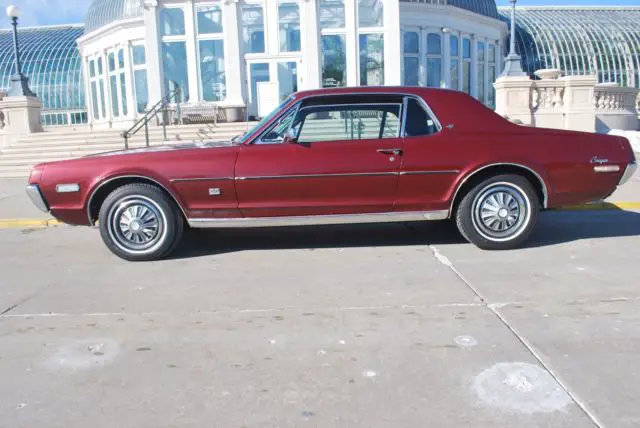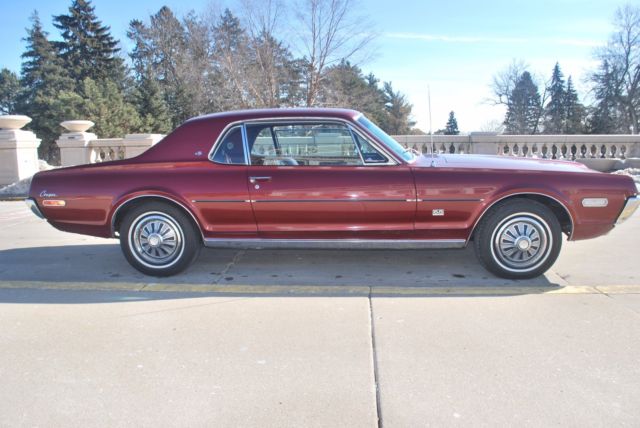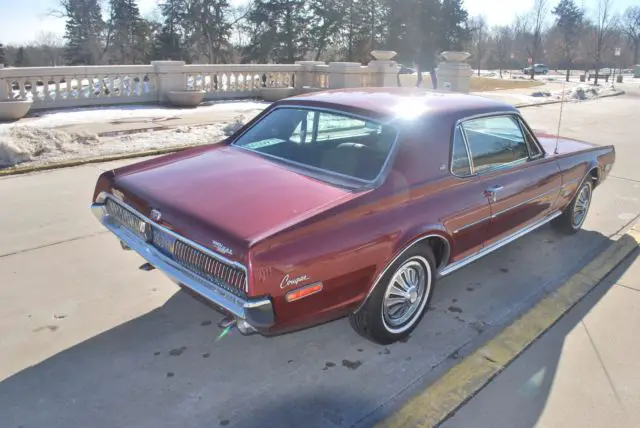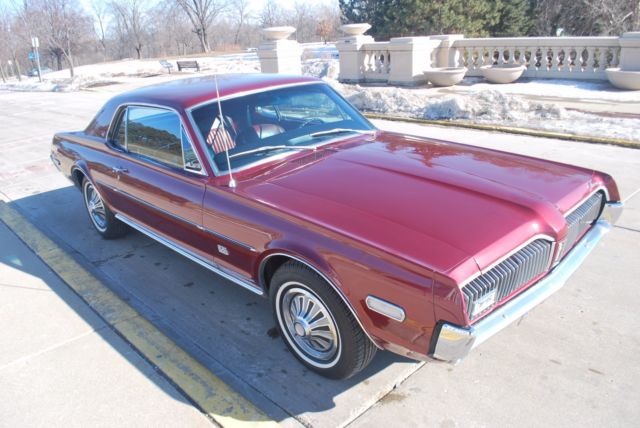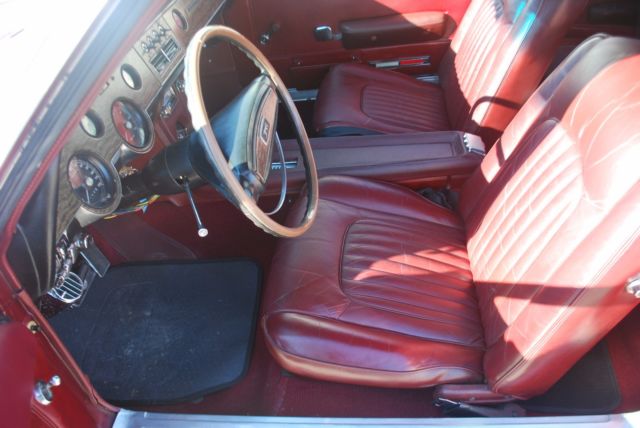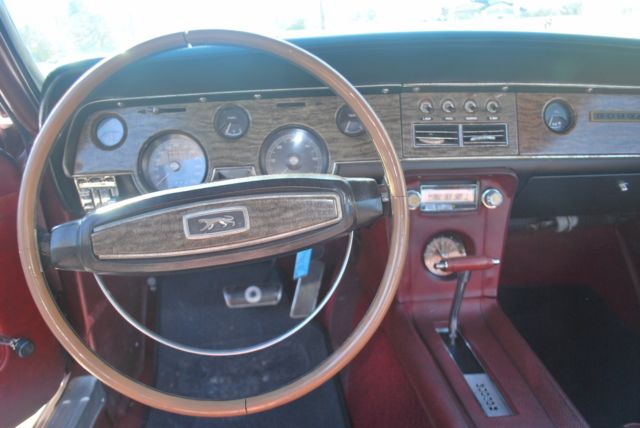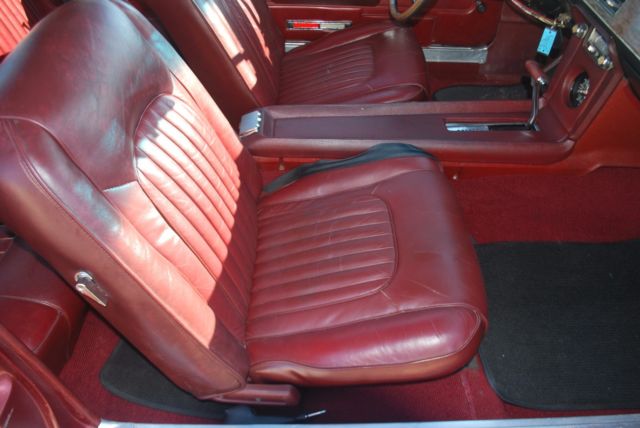1968 MERCURY COUGAR XR-7 390 V-8 BIG BLOCK
Technical specifications of Mercury Cougar 1968
| Price: | - |
|---|---|
| Item location: | Saint Paul, Minnesota, United States |
| Make: | Mercury |
| Model: | Cougar |
| Type: | Coupe |
| Trim: | XR-7 |
| Year: | 1968 |
| Mileage: | 45,000 |
| VIN: | 8R93X511448 |
| Color: | Burgundy |
| Engine size: | 390 |
| Number of cylinders: | 8 |
| Power options: | POWER STEERING, Air Conditioning |
| Fuel: | Gasoline |
| Transmission: | Automatic |
| Drive type: | RWD |
| Interior color: | Burgundy |
| Options: | HIDE AWAY HEADLIGHTS, Leather Seats |
| Vehicle Title: | Clear |
| You are interested? | Contact the seller! |
Description
First generation (1967–1970)[edit]| 1967 Mercury Cougar |
| 1967–1970 (1969–70 are the second body shape) |
| United States:Dearborn, Michigan Edison, New Jersey Milpitas, California |
| 2-doorhardtop 2-doorconvertible |
| FR layout |
| Ford Mustang |
| 289cuin (4.7L)WindsorV8 390cuin (6.4L)FEV8 302cuin (4.9L)WindsorV8 351cuin (5.8L)WindsorV8 351cuin (5.8L)ClevelandV8 428cuin (7.0L)FEV8 427cuin (7.0L)FEV8 |
| 111 in (2819 mm) |
| 1967: 190.3 in (4834 mm)[3] 1969: 193.8 in (4923 mm) 1970: 196.1 in (4941 mm) |
| 1967: 71.2 in (1808 mm) 1969: 75.0 in (1905 mm) 1970: 74.2 in (1885 mm) |
| 1967: 51.8 in (1316 mm) 1969: 51.9 in (1318 mm) 1970: 51.3 in (1303 mm) |
The introduction of the Cougar finally gave Mercury its own "pony car". Slotted between the Ford Mustang and the Ford Thunderbird, the Cougar was the performance icon and eventually the icon for the Mercury name for several decades. The Cougar was available in two models (base and XR-7) and only came in one body style (a two-doorhardtop, no center or B-pillar). Engine choices ranged from the 200hp (149kW) 289cuin (4.7L) two-barrelV8to the 335hp (250kW) 390cuin (6.4L) four-barrel V8. A performance package called the GT was available on both the base and XR-7 Cougars. This included the 390cuin (6.4L) V8, as well as a performance handling package and other performance enhancements.
The 1967 Cougar, with the internal code T-7, went on sale September 30, 1966.[4]It was based on the 1967 refaced first-generation Mustang,[5]but with a 3-in-longer (76mm) wheelbase and new sheet metal. A full-width divided grille withhidden headlampsand vertical bars defined the front fascia—it was sometimes called the electric shaver grille. At the rear, a similar treatment had thelicense platesurrounded on both sides with vertically slatted grillework concealing tail lights (withsequential turn signals), a styling touch taken from the Thunderbird.
A deliberate effort was made to give the car a more "European" flavor than the Mustang, at least to American buyers' eyes, drawing inspiration from the popularJaguar E-Type. Aside from the base model and the luxurious XR-7, only one performance package was available for either model: the sporty GT. The XR-7 model brought a simulated wood-graineddashboardwith a full set of black-faced competition instruments and toggle switches, an overhead console, a T-type center automatic transmission shifter (if equipped with the optional Merc-O-Matic transmission), and leather-vinyl upholstery.
This was the only generation with covered headlights. In 1967 and 1968, they were deployed using a vacuum canister system that opened and closed the headlamp doors. For 1969 and 1970, a redesigned vacuum system kept the doors down when a vacuum condition existed in the lines, provided by the engine when it was running. If a loss of vacuum occurred, the doors would retract up so that the headlights were visible if the system should fail.
The GT package, included Ford's 390cuin (6.4L)FE-series big block, along with an upgraded suspension to handle the extra weight of the big engine and give better handling, more powerful brakes, better tires, and a low-restriction exhaust system. Introduced with the music ofHerb Alpertand the Tijuana Brass' "The Work Song", the Cougar was a sales success from its introduction and helped the Lincoln-Mercury Division's 1967 sales figures substantially. The Cougar wasMotor Trendmagazine'scar of the yearfor 1967.
The Cougar continued to be a Mustang twin for seven years, and could be optioned as amuscle car. Nevertheless, the focus continued away from performance and toward luxury, evolving it into a plush pony car. The signs were becoming clear as early as 1970, when special options styled by fashion designerPauline Trigèreappeared, ahoundstooth-patternedvinyl roofand matching upholstery, available together or separately. A facelift in 1971 did away with the hidden headlights and hidden wipers were adopted. Between 1969 and 1973, Cougarconvertibleswere offered.
The 1968 model year included federally-mandatedside marker lightsand front outboardshoulder belts (sash belt, shoulder harness)among some minor changes. A 210hp (157kW) 302cuin (4.9L) two-barrel V8 was the base engine on all XR-7s and early standard Cougars. Three new engines were added to the option list this year: the 230hp (172kW) 302cuin (4.9L), four-barrel V8; the 335hp (250kW) 428cuin (7.0L), four-barrel V8; and the 390hp (291kW) 427cuin (7.0L), four-barrel V8. In addition, the 289cuin (4.7L) engine was made standard on base cars without the interior decor group midway through the model year.
Comfort and performance options available for the Cougar included the "Tilt-Away" steering wheel that swung up and out of the way when the driver's door was opened (and the ignition was off), and from 1971, a power driver's seat. The new option appeared in 1968: Ford's first factory-installed electric sunroof. It was available on any hardtop Cougar, but rarely ordered on early cars.
Mercury also made limited versions of Cougar in the performance-market segment. The XR7-G, named for Mercury road racerDan Gurney, included performance add-ons, such as ahood scoop, Lucas (brand) fog lamps, and hood pins. Engine selection was limited to the 302, 390, and 428 V8s. A total of 619 XR7-Gs were produced, and only 14 Gs were produced with the 428 CJ. The 7.0-L GT-E package was available on both the standard and XR-7 Cougars and came with the 427 V8. The 428 Cobra Jet Ram Air was available in limited numbers on the GT-E beginning 1 April 1968.[6]Conservatively rated at 335hp (250kW), the 428 Cobra Jet could produce more than the (306kW (410hp)) from the factory. A total of 394 GT-Es were manufactured, 357 with the 427 and 37 with the 428.[7]The GT-E came with power front disc brakes as standard.[8]
